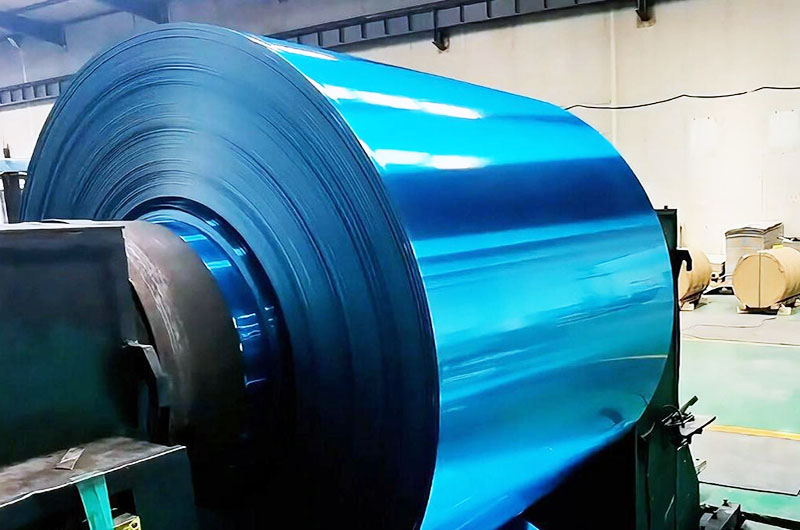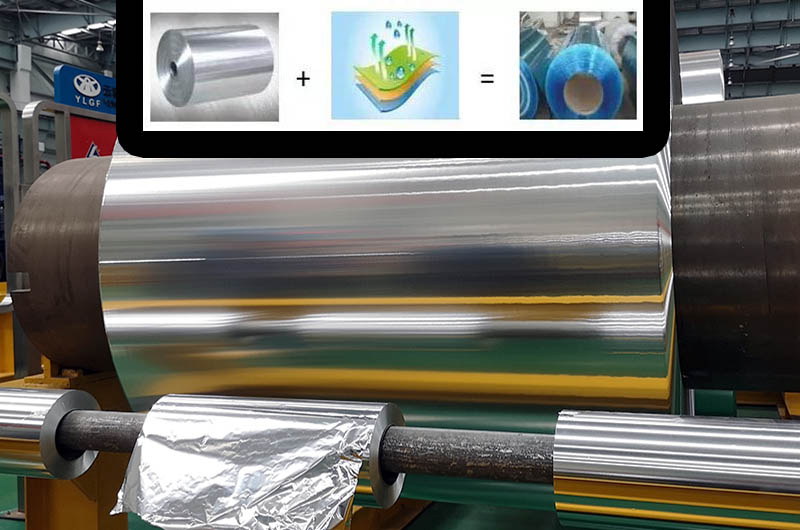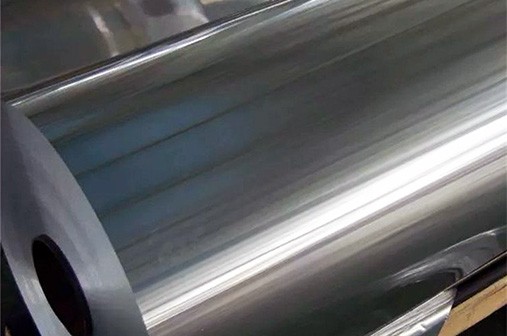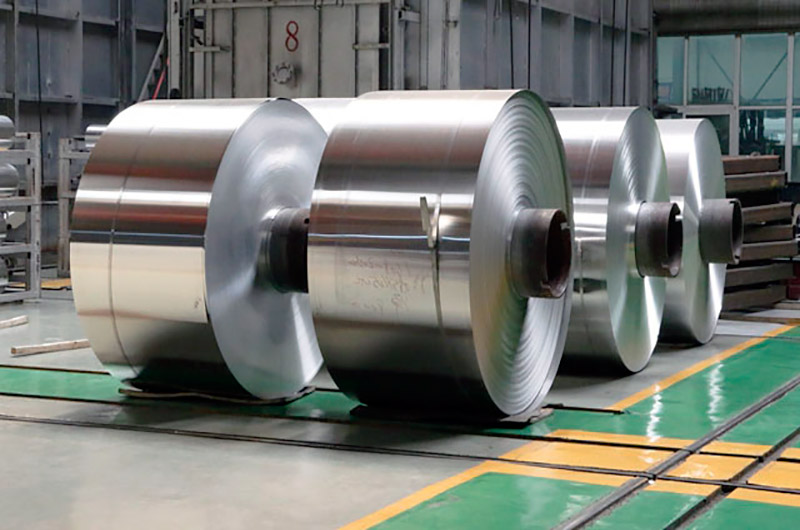- 6 Advantages of Hydrophilic Aluminum Foil
- Hydrophilic Aluminum Foil Classification
- Hydrophilic Aluminum Foil Main Treatment Methods
- Production Process Flow of Hydrophilic Aluminum Foil
In the South, what are the most indispensable electrical appliances in winter and summer?
Answer: Air conditioning!
Today we will talk about: hydrophilic aluminum foil used in air conditioners
Hydrophilic aluminum foil vs ordinary aluminum foil
The magic of hydrophilic aluminum foil is that it has been surface treated with a hydrophilic layer.
The performance of the aluminum foil with the hydrophilic layer also changes accordingly. The hydrophilic layer can make the water droplets condensed in the hot air on the heat exchanger easily spread and flow downward along the sheet. This can avoid the heat exchanger being damaged by the heat exchanger. The water droplets "bridge" between them affect the ventilation effect of the heat exchanger, thereby increasing the heat exchange rate by 5%.

6 Advantages of Hydrophilic Aluminum Foil
- extend your life
- reduce noise
- Dust removal
- Anticorrosive
- odorless
- Anti-fungal
Extended life: It can improve the corrosion resistance and weather resistance of the heat exchanger and extend the service life of the heat exchanger.
Reduce noise: Since there are no water droplets, the air conditioning noise caused by vibration can be reduced accordingly.
Dust removal: It can prevent the oxidized powder from the air conditioner from blowing into the room and causing adverse effects on the human body, and meets environmental protection requirements.
Hydrophilic Aluminum Foil Classification
Hydrophilic aluminum foil classified by color
Hydrophilic aluminum foils are typically manufactured in a variety of colors for a variety of applications, with color classifications often related to the type of coating or treatment applied to the foil. Here are some common color classifications of hydrophilic aluminum foil:
Bare/plain hydrophilic aluminum foil
Some hydrophilic aluminum foils maintain their natural silver or aluminum color without additional tinting. This is common when the foil has undergone a treatment that does not involve the addition of pigments or dyes.
Blue hydrophilic aluminum foil
Blue hydrophilic foil is common. A blue color usually indicates the presence of a hydrophilic coating that enhances the foil's water-absorbing properties. Blue is a typical color choice for this application.
Gold/yellow hydrophilic aluminum foil
Gold or yellow hydrophilic foil can be used for aesthetic reasons or to distinguish it from other types of foil. Color does not necessarily affect hydrophilic properties but can be used for branding or identification purposes.

It should be noted that the color of hydrophilic aluminum foil is not necessarily directly related to its hydrophilic performance. Hydrophilic properties are primarily determined by surface treatments or coatings applied during the manufacturing process.
According to hydrophilic properties
Hydrophilic aluminum foil is divided into initial hydrophilicity and sustained hydrophilicity.
- Initial hydrophilic aluminum foil
- Continuously hydrophilic aluminum foil
Initial hydrophilic aluminum foil:
This refers to the initial or starting hydrophilic character of the aluminum foil. The foil is treated or coated to exhibit hydrophilic properties from the outset. This treatment ensures that the foil has an affinity for water from the outset, allowing it to interact effectively with water or condensation.
Continuous hydrophilic aluminum foil:
This means that the hydrophilic properties of aluminum foil are maintained over the long term. The foil is designed or treated in such a way that it maintains its hydrophilicity throughout its expected service life. This sustained hydrophilicity is important in applications such as heat exchangers, where consistent and long-term water diffusion and heat transfer efficiency are critical.
Hydrophilic Aluminum Foil Main Treatment Methods
Single coating and single baking method and double coating and double baking method.
The single coating and single baking method is to degrease the aluminum foil and then chemically oxidize it to form a chemical conversion film on the surface of the aluminum foil, and finally apply a hydrophilic coating. This method has simple process and low cost.
Production Process Flow of Hydrophilic Aluminum Foil
- open book
- preprocessing
- Surface roller coating (first roller coating, first drying, second roller coating, second drying)
- Take up
The function of pretreatment: mainly to enhance the bonding force between the coating and the aluminum foil.
Function of coating: The coating plays a role in increasing the hydrophilicity and corrosion resistance of the product.
For products with higher performance requirements, if the primary coating fails to meet the required indicators, a secondary coating is required.
- single-coat products have both hydrophilic and corrosion-resistant functions in one coating.
- double-coated products, the first coating has a corrosion-resistant effect, and the second coating has a hydrophilic effect.
Hydrophilic aluminum foil is often used in the manufacture of heat exchangers, especially in air conditioning and refrigeration systems. In these applications, hydrophilic aluminum foil is used as a component of heat exchanger fins. The hydrophilic surface helps promote efficient and even diffusion of water or condensation across the foil surface. This is important for heat transfer efficiency because it allows the water to form a thin film on the surface, promoting better heat exchange between the refrigerant and the surrounding air.
Hydrophilic aluminum foil is designed to prevent water droplets from forming on the surface, which would otherwise reduce heat transfer efficiency. The treatment may involve applying a hydrophilic layer to the foil or changing its surface properties so that it absorbs water.
Overall, the use of hydrophilic aluminum foil in heat exchangers helps improve the performance and energy efficiency of air conditioning and refrigeration systems.
Informations you may be interested in:
- Which is better, hydrophilic aluminum foil or copper foil for air conditioners
- Hydrophilic aluminum foil vs non-hydrophilic aluminum foil
- Solutions to hydrophilic aluminum foil problems
- Hydrophilic aluminum foil performance indicators
- What components in air conditioning systems use aluminum foil?
- How is aluminum foil used for thermal insulation in air conditioning systems?
- Can aluminum foil be used in outdoor air conditioning units?
- Comprehensive analysis of air conditioning aluminum foil: classification and applications
- What kind of material is air conditioning aluminum foil made of and what are its
- 1050 Versatility in Air Conditioner Aluminum Foil Applications


